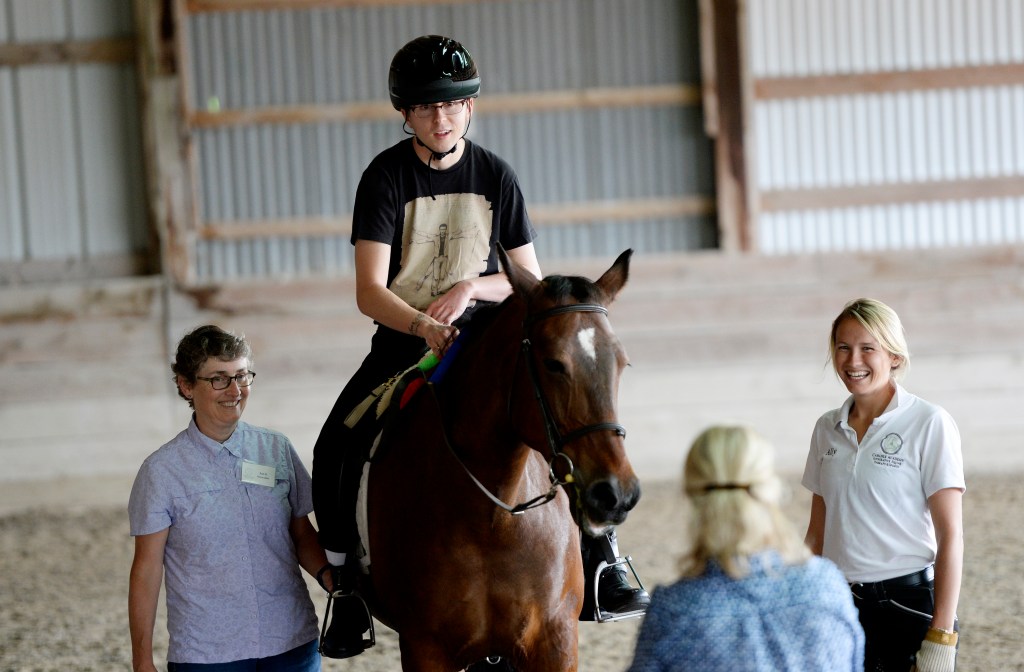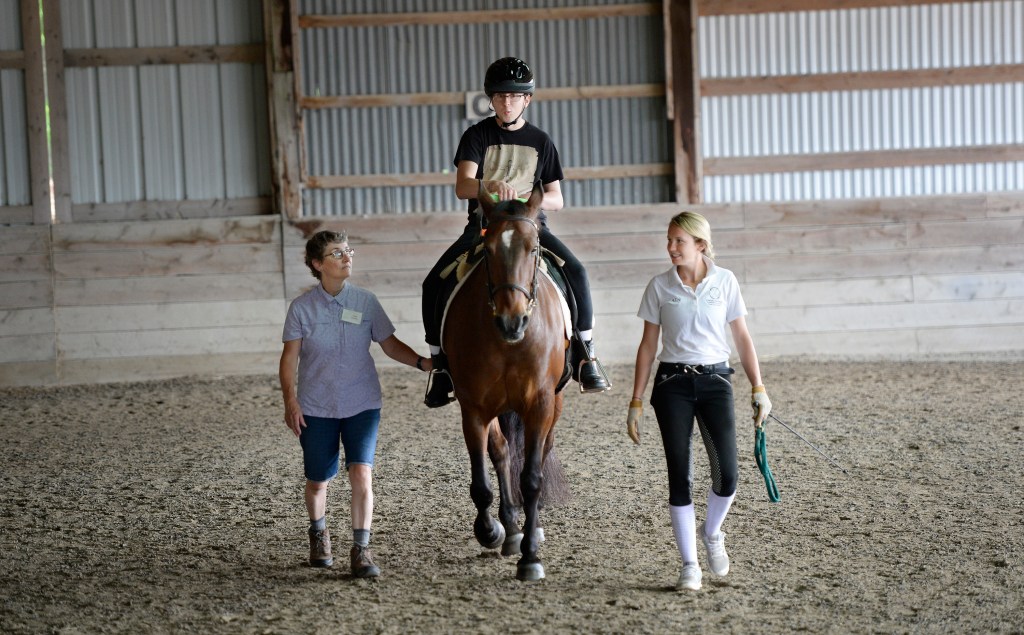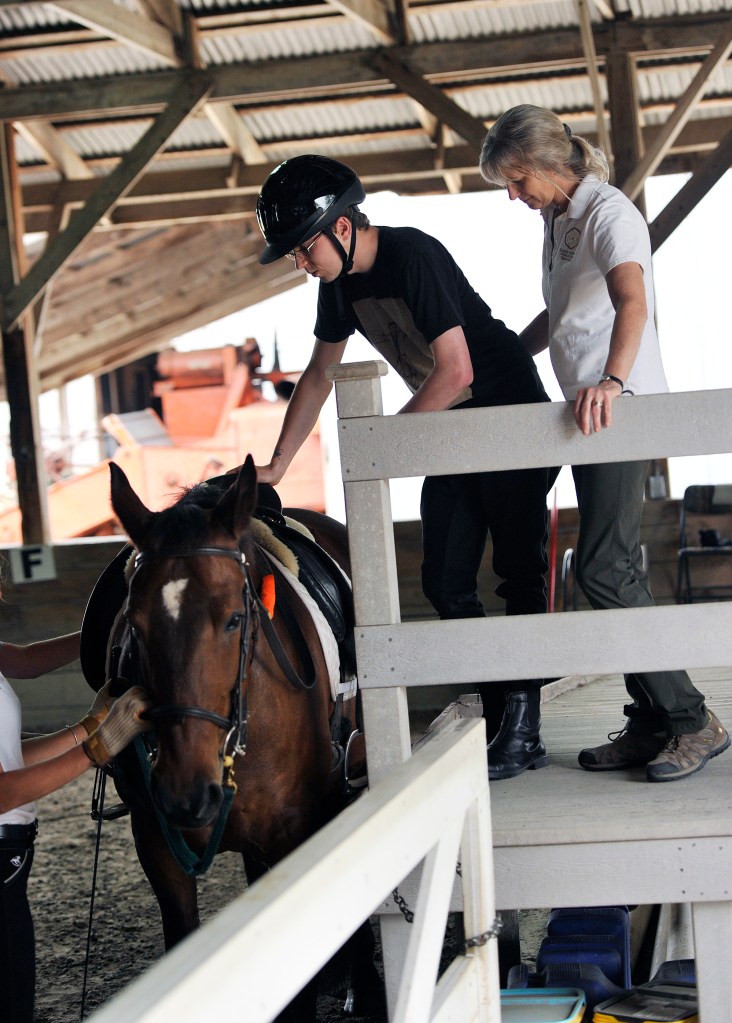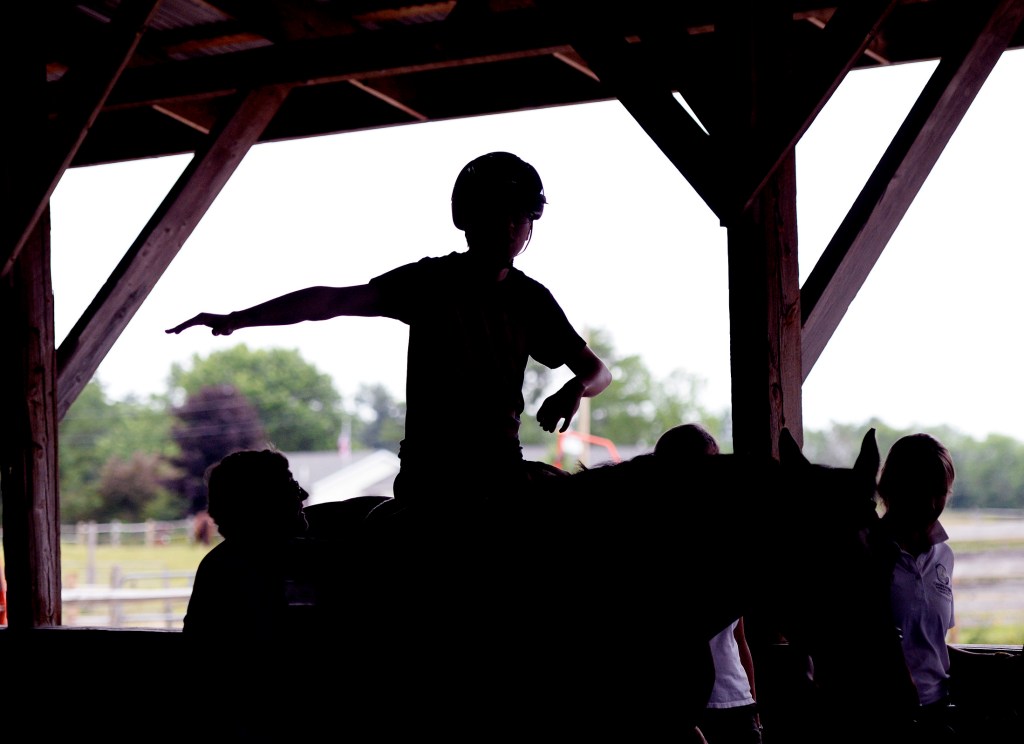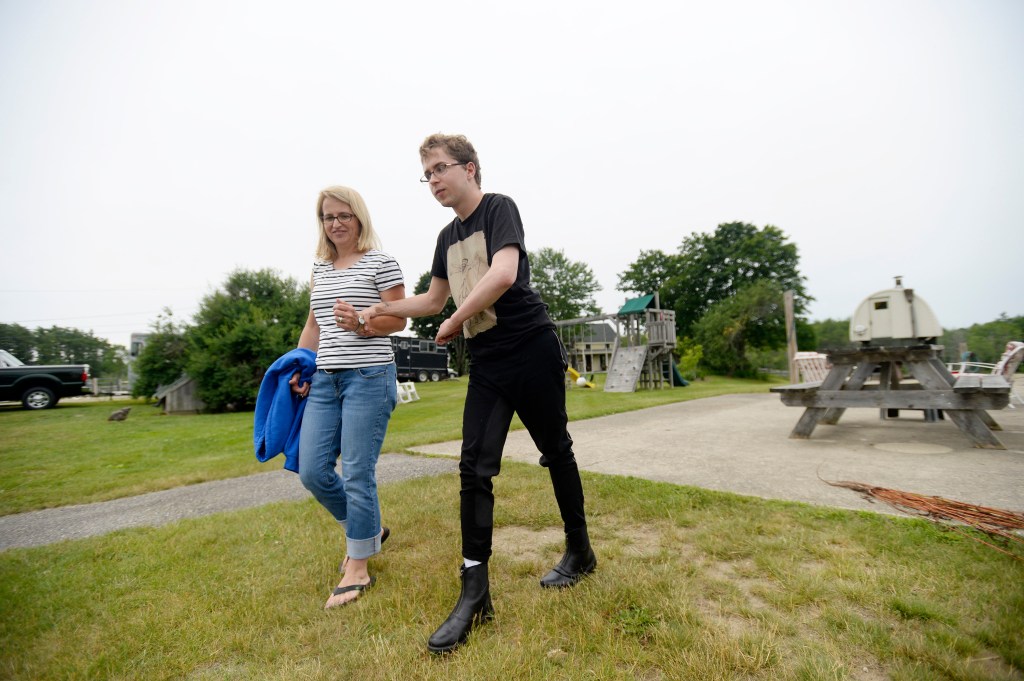LYMAN — Before the accident, Joe Reidy had ridden a horse just once, on a trip to Jackson Hole, Wyoming, with his dad.
Reidy, then 18, had no idea how much time he’d come to spend on the back of a horse. Days after starting college in Vermont, he was hit by a car as he crossed the street, the impact so hard it left him with a severe traumatic brain injury in addition to a broken leg.
After months in the hospital and rehabilitation center and years of physical therapy, Reidy turned to horses to help improve his balance and strength. Nearly three years after he first rode around an arena at Carlisle Academy, he is ending his weekly therapeutic riding sessions. But he will keep riding as part of an adaptive equestrian sports program that will allow him to eventually compete as a para-equestrian.
 “It’s time to move on,” Reidy said.
“It’s time to move on,” Reidy said.
He arrives on a sunny Thursday afternoon for one last hippotherapy session before he starts training with Sarah Armentrout, the head of school and co-founder of Carlisle Academy. Over the next year, he’ll learn to ride independently and how to compete in shows with other para-equestrians.
Holding his mom’s arm for balance as he walks, Reidy makes his way into the covered riding arena. The black helmet he straps on matches his riding boots and pants. At the top of a ramp, physical therapist Janet Smaldone steadies him as he swings his leg over the horse and sits onto the saddle.
Reidy straightens himself in the saddle as his horse, Mabel, steps forward into the riding arena.
“Good job, Joey,” calls out Ally Abrahamson, the horse handler who leads Mabel during the session.
THE ACCIDENT AND THE LONG ROAD BACK
Reidy, now 24, grew up on Vinalhaven. He’d traveled a bit – to Europe and the Caribbean and around the U.S. – but had grown up sheltered in a community of barely more than 1,000 people a 90-minute ferry ride off the coast.
After high school, he headed to Champlain College in Burlington, Vermont. Two weeks into his first semester in 2011, he was making friends and enjoying his classes. He felt like he’d landed at the place he belonged.
On a Friday night, he headed out to grab some beer to share with his friends. As he crossed the street in a crosswalk on his way back to the dorm, he was hit on his left side by a Volkswagen Jetta traveling 30 mph. Neither Reidy nor the driver had alcohol in their systems.
Critically injured, Reidy was rushed to the intensive care unit at Fletcher Allen Health Center. The impact was so hard that Reidy’s brain literally turned in his head, causing a severe brain injury.
It wasn’t clear at first whether he’d live.
Twelve days later, he opened his eyes for the first time since the accident. In mid-October, after weeks in intensive care, Reidy was transferred to a hospital and then a rehabilitation center in Boston. By then, he had said “hey” to a nurse and was snapping his fingers.
“Things kept looking up, but I knew I still had a long road ahead of me,” Reidy wrote in “My Nightmare … and How I Woke Up From It,” a digital book he wrote to document his recovery.
He spent Thanksgiving, Christmas and his birthday in rehab. During physical therapy, he stood using parallel bars. He had chocolate pudding, his first bite of food. He hugged his mom for the first time since she dropped him off at college in August.
On Feb. 15, 2012 – 159 days after the accident – Reidy went home to Vinalhaven. As the ferry came into the harbor, a friend rode by in his lobster boat with a sign reading: “Welcome Home, Joey.” Fire trucks and crowds of islanders met him at the dock, and Main Street was lined with friends chanting Reidy’s name and cheering.
He felt like a hero.
‘I’M ON THE OTHER SIDE OF IT NOW’
Reidy was home, but he still had a lot of work ahead of him. His parents had turned part of the house into a gym, with mats and some of the equipment he needed to do physical therapy. He also had time to reflect on the significance of the accident and write his book.
He describes the accident and recovery as “all the bad experiences I’ve ever had rolled into one.” But there were things he learned, he wrote. He can see the world through the eyes of a person with a disability. He knows more about therapy than he ever imagined. He’s stronger now.
“I feel like I’m on the other side of it now. I can look back and say, ‘Yeah, I did that.’ It’s a bit like traveling – like I’ve been on a very long, awful trip. But it will be over soon,” he wrote.
Reidy went back to college for two semesters, using a motorized wheelchair to get around. But his body wasn’t as strong as he wanted it to be, so he came home to Maine to focus on it. By 2014, Reidy had learned about the benefits of hippotherapy and wanted to try it. The rhythm of the horse’s movement stimulates the rider’s muscles and helps build muscle memory and strength. When a person is on the horse, the walking gait mimics the normal human gait.
“Riding horses is really good for balance and that’s what I need,” Reidy said.
They found Carlisle Academy, tucked away on a farm in rural Lyman, and Reidy started riding every week. They’d take the ferry over to the mainland from Vinalhaven, then travel two hours by car to Saco. The journey, plus the therapy session, took so long they had to stay overnight in hotels.
Eventually, the family decided to buy a house in Saco so Reidy and his mother would be closer to Carlisle Academy and to Boston, where Reidy attends physical therapy three times a week and plays tennis, water sports and cycles with Accessport America. His father still lives and works on Vinalhaven during the week and visits on weekends.
“He’s been very focused and determined because he does not want to live with me the rest of his life,” Heather Reidy says of her son.
READY FOR A NEW CHALLENGE
Sitting atop Mabel and at the direction of Smaldone, Reidy works his way through a series of stretches, extending his arms and holding his back tall and straight.
When Reidy first started riding, he’d sit hunched over to one side, his core muscles too weak to allow him to maintain the proper riding posture. He sat on padding instead of a saddle.
“When I first started I really didn’t see much benefit,” Reidy says. “As I kept doing it, I realized more and more the benefit of it.”
Now, he sits up straight in the saddle and practices the post and trot. His core strength is now symmetrical, says Smaldone, who has worked with Reidy every week since the start.
“I think it’s given him more confidence, for sure,” Heather Reidy says. “He has no fear. I don’t know if that’s the brain injury or being 24 years old.”
Through all the hippotherapy sessions, Reidy came to enjoy his riding time. He’s ready now, he says, to move on to a new challenge. During therapy, a horse handler always guided the horse. As he prepares to compete in shows, Reidy will learn to do that independently.
Reidy and Mabel circle the arena, then head back toward the front. Abrahamson, the handler, lets go of the lead and steps a bit farther away from the horse. It’s the first time Reidy has ever steered the horse on his own.
“This is pretty neat,” his mother says.
Armentrout stands at the center of the ring, calling out directions to Reidy. He’s doing a good job, she says.
Smiling, Reidy grips the reins in his right hand, guiding Mabel through a turn and again around the arena.
Gillian Graham can be contacted at 791-6315 or at:
Twitter: grahamgillian
Send questions/comments to the editors.


